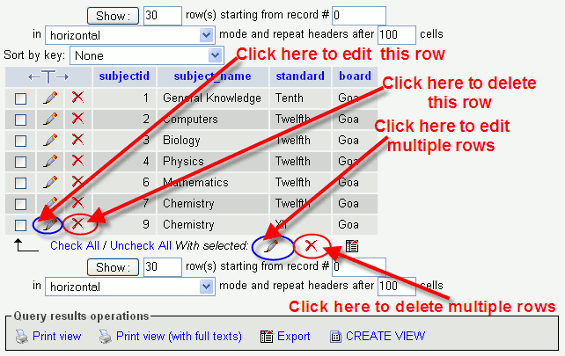INSERT INTO table (colcol2) VALUES (2),(4),(6) I would like to delete multiple rows in a similar way. Delete many rows from a table using id in. If you omit the WHERE clause, the DELETE statement will delete all rows in the table.
Besides deleting data from a table, the DELETE statement returns the number of rows deleted. To delete data from multiple tables using a single DELETE statement, you use the DELETE JOIN statement which we will cover in the next tutorial. For the first multiple -table syntax, only matching rows from the tables listed before the FROM clause are deleted. For the second multiple -table syntax, only matching rows from the tables listed in the FROM clause (before the USING clause) are deleted.
The effect is that you can delete rows from many tables at the same time and have additional. Once the duplicates rows are identifie you may want to delete them to clean up your data. In this tutorial create file 1. Create file delete _ multiple. That, in my opinion, would more clearly be conveying the intention: delete rows rather than the tables themselves.
And last, but not least, point from the comments is that if only one of the tables has the matching rows , your DELETE statement will fail to delete any rows at all. It will be easy, when user delete multiple rows on a single click. This is useful when you want to delete rows depending upon a complex condition.
First let’s look at ways to delete multiple consecutive rows or columns. Firstly, select a series of rows or columns and right click. Yet, we have seen about how to update and delete table rows one at a time. The example code to delete multiple rows with checkbox on a single click in PHP.

You just need to add checkbox with each records and allow to select checkbox and then implement functionality to delete multiple selected records through single delete button. A collection of FAQs on Oracle SQL DML statements. I can select multiple rows with one condition by using something like: SELECT `Col`, `Col2` FROM `Table` WHERE `Col3` IN (?, ?, ?, ?, ?);.
Selecting Multiple Rows in One Query with Multiple Conditions. Ask Question Asked years,. The WHERE clause is very useful when you want to delete selected rows in a table. If the WHERE clause is not used in the DELETE query, then all the rows in a given table will be deleted. As you can see there are multiple ways to delete rows from a SQL Server table.

You can use the WHERE clause to identify specific criteria for the rows that need to be deleted. You can join a table to the table in which you are deleting rows to identify which rows to delete. Hoping someone can help me out. However, this little problem has me stumped. I have a table (very large one) that contains about 2categories and is 30rows long, more or less.
I need to trim this table down to only the categories. Examples, The best For Learn web development Tutorials,Demo with Example! MySQL Forums Forum List Newbie.
You can specify multiple tables in a DELETE statement to delete rows from one or more tables depending on the particular condition in the WHERE clause. The table_references clause lists the tables involved in the join. SQL DELETE – deleting related rows in multiple tables. It becomes more complicated when you want to delete a row in a table that is associated with other rows in another table.
For example, each employee is working in one or more territories and each territory has multiple employees. The user has to tick the checkbox to pick on the rows to delete. This tutorial will show you how to update multiple rows with one time submittion. Easy and simple code teach you step by step. Copy and paste the following SQL to your SQLyog free Community Edition query window.

Note that the SQL needs to end with semi-colon if you have multiple queries in the query window. Else, the same job can be done with help of script. My approach when writing script to mo.
Insert or delete cells, rows , and columns Article;. To insert multiple rows : Select the same number of rows above which you want to add the new ones.
Hiç yorum yok:
Yorum Gönder
Not: Yalnızca bu blogun üyesi yorum gönderebilir.